
Doppelmayer is the remains of a lunar impact crater that lies on the southwest edge of Mare Humorum. It was named after the German mathematician and astronomer Johann Gabriel Doppelmayr. To the south-southeast is another flooded crater designated Lee, and to the southeast is Vitello. Just to the east-northeast of Doppelmayer lies the nearly submerged crater Puiseux.

Babcock is a lunar impact crater that is located on the far side of the Moon. It was named after American astronomer Harold D. Babcock. It lies on the northeastern edge of Mare Smythii, to the southeast of Mare Marginis. To the south of Babcock is the crater Purkynĕ, and to the east-northeast lies Erro. Babcock is located in a region of the Moon's surface that is occasionally brought into view during favorable librations, although it is seen from the edge and so little detail can be discerned from an observer on the Earth.

Byrd is an irregular lunar impact crater that is located near the north pole of the Moon. The north rim of Byrd is nearly connected to the crater Peary, a formation that is adjacent to the pole. The smaller crater Gioja is attached to the remains of the southwest rim.

Tempel is the remnant of a lunar impact crater whose outer rim has been eroded, indented, and reshaped by subsequent impacts and lava flows. It is attached to the eastern rim of the crater Agrippa, in an area that has been resurfaced by old lava flows. To the southwest is Godin, and to the east lies the small, bowl-shaped Whewell. Its diameter is 43 km. The crater was named after German astronomer Wilhelm Tempel.

Chamberlin is a lunar impact crater that is located on the far side of the Moon, just past the southeastern limb. It lies to the southeast of the crater Jeans, and Moulton is attached to the southeastern rim of Chamberlin. This crater is located in a part of the lunar surface that has undergone resurfacing of crater interiors, producing dark-hued crater floors.
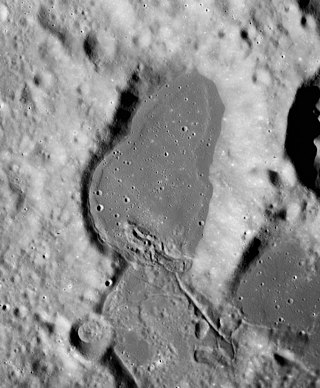
Bowditch is a lunar impact crater that lies on the far side of the Moon, just beyond the eastern limb. It is located on a region of the lunar surface that is brought into view due to libration, but at such times the area is viewed from the edge and so not much detail can be observed. It lies just to the north of the small Lacus Solitudinis lunar mare, between the craters Titius to the southwest and Perel'man to the east-northeast.

Baldet is a lunar impact crater that is located on the southern hemisphere on the far side of the Moon. It lies in the lava-flooded region between the craters Cori to the north, Stoney to the southwest, and the worn walled plain Minkowski to the southeast.

Cannon is a lunar impact crater that is located near the east-northeastern limb of the Moon's near side. It lies just to the northwest of the Mare Marginis, and south-southeast of the crater Plutarch. Farther to the east-northeast is Hubble.
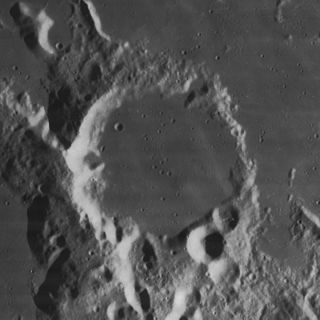
Capuanus is a lunar impact crater that lies along the southern edge of the Palus Epidemiarum. It was named after Italian astronomer F. Capuano di Manfredonia. The outer rim is eroded and indented by lesser crater impacts, with notches in the north, west, and southern parts of the rim. The interior floor has been resurfaced by basaltic lava, which is connected to the surrounding lunar mare by a narrow, crater-formed gap in the northern rim. Dotting the floor of the crater are a number of domes, which are believed to have formed through volcanic activity.

Cusanus is a lunar impact crater that is located near the northeastern limb of the Moon. In this location the crater appears very foreshortened when observed from the Earth, and its visibility is affected by libration. The northern rim of Cusanus is nearly joined to the south-southeastern rim of the larger crater Petermann. To the west is Baillaud and to the southeast is Hayn.

Elger is a lunar impact crater that lies along the southern edge of Palus Epidemiarum, the Marsh of Epidemics, in the southwest part of the Moon's near side. To the northeast is the flooded crater Capuanus, and farther to the northwest is Ramsden.

Pascal is a lunar impact crater that lies near the northern limb of the Moon, on the western side of the pole. It is located to the north of the eroded crater Desargues, and just east of Brianchon. Pascal can be located by finding the crater Carpenter and then following the surface to the northwest towards the limb. However the visibility of this formation can be affected by libration.

Chevallier is a lunar impact crater that is located in the northeastern part of the Moon's near side, about a crater diameter east-southeast of the prominent crater Atlas. To the south-southeast of Chevallier is the flooded crater Shuckburgh.
Cooper is a lunar impact crater that is located in the northern hemisphere on the far side of the Moon. It lies to the east of the large walled plain D'Alembert, and west-southwest of the crater Chappell.

Dyson is a lunar impact crater, 63 kilometers in diameter, that lies on the far side of the Moon, past the northwest limb. It is located in the northern part of the surface, to the northwest of the crater Coulomb, and east of van't Hoff.
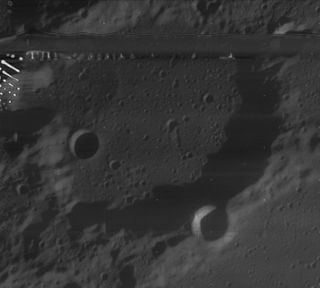
Euctemon is a lunar impact crater that is located in the northern part of the Moon, along the northwest rim of the crater Baillaud. To the southwest of Euctemon is the large walled plain Meton, and to the north-northeast lies the crater De Sitter. Due to its location, Euctemon appears foreshortened when viewed from the Earth.
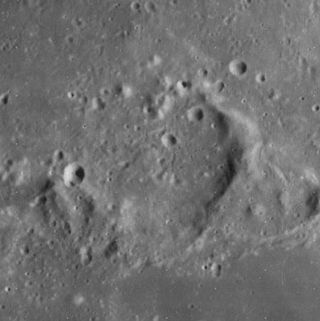
Williams is the remnant of a lunar impact crater that lies to the south of the prominent crater Hercules, in the northeastern part of the Moon. The southern rim borders the Lacus Somniorum, a small lunar mare that extends to the south and west. To the southwest is the sharp-rimmed crater Grove.
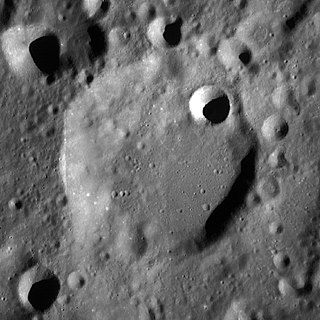
Evdokimov is a lunar impact crater on the far side of the Moon. It lies to the east of the crater Evershed, and west-southwest of Gadomski. This is a worn and eroded feature with a somewhat indistinct outer rim that is little more than a slight ridge in the surface. The rim is better formed along the western and eastern sides. A small crater with a relatively high albedo lies along the inner wall to the northeast, and is surrounded by a small, bright skirt of ejecta. The interior floor is nearly featureless, with only a few indistinct small crater rims marking the surface.

Lomonosov is a lunar impact crater that is located just behind the western limb of the Moon. It is almost attached to the east-northeastern outer rim of the larger crater Joliot, and overlies the southern rim of Maxwell. Attached to the southern rim of Lomonosov is the smaller Edison.
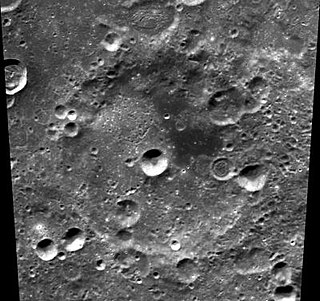
Minkowski is a crater on the far side of the Moon, in the lower latitudes of the southern hemisphere. The lunar crater lies about one crater diameter to the north-northeast of crater Lemaître, a formation of similar dimension. To the northwest of Minkowski is the flooded crater Baldet, and to the southeast lies Fizeau.






















